Tenacious Tansy
By Audrey Stallsmith

Tight flower that takes the spice of all the fields
And holds it fast with seals of ancient gold,
And never with unguarded petals yields
What other flowers at every breeze unfold.
"Tansy" by Julia Cooley Altrocchi
To celebrate the graduation of my niece Tansy, I thought I'd write about the herb that is her namesake. But, though my niece is a gifted young woman with a pretty face and name, the original tansy has a more equivocal reputation.
In The Fragrant Path, Louise Beebe Wilder calls it "a tall, coarse, beautiful wayward weed, with lacelike leaves and heads of tarnished gold buttons." Tansy's bracing scent, which has been compared to a mix of camphor and rosemary, also made it a popular strewing herb in ancient times as it supposedly repels insects. It was even rubbed on meat sometimes to fend off flies.
Its name, tanacetum, derives from the Greek athanaton or "immortal." That could be a reference to how long its flowers last or how well they dry.
It was also supposed to enhance beauty, according to Master Jherom Brunswyke's 1527 Virtuouse Boke of Distyllacion. "I have heard that if maids will take wild Tansy and lay it to soake in Buttermilk for the space of nine days and wash their faces there with, it will make them look very faire." A similar concoction from Gene Stratton Porter's A Girl of the Limberlost sounds a bit painful, however.
"Later she went out beside the west fence and gathered an armful of tansy which she boiled to a thick green tea. Then she stirred in oatmeal until it was a stiff paste. She spread a sheet over her bed and began tearing strips of old muslin. She bandaged each hand and arm with the mixture and plastered the soggy, evil-smelling stuff in a thick poultice over her face and neck. . .By the third morning she was a raw even red, the fourth she had faded to a brilliant pink under the soothing influence of a cream recommended ...The following day she was a pale pink, later a delicate porcelain white."
Fortunately, nobody wants to be that pale these days! Tansies--omelets or puddings flavored with the herb--were also popular during or just after Lent, as symbolic of the bitter herbs served at the original Jewish Passover. And tansy has been used to treat everything from hysteria and kidney problems to fevers, indigestion, skin diseases, and gout.
But that adds a certain "bitterness" to Wilder's further description of the herb. "A generation or so ago it was in high repute among us as a medicinal plant and Tansy Tea was a frequent affliction that had to be suffered by the young and helpless. . .In England Tansy cakes were an Easter provision, whether in expiation of sins or as a reward I do not know. . .What hardy stomachs must our forefathers have possessed!"
Actually our forefathers seem to have enjoyed their "tansies"--since Gerard refers to their "pleasant taste." But they were also supposed to relieve the effects of too much salt fish during Lent--which was believed to cause both indigestion and intestinal worms. And, like most vermifuges--worm expellers--tansy is somewhat toxic.
In fact, the amount of thujone found in any particular plant is wildly unpredictable, so people have died from ingesting relatively small amounts. Plus tansy's vaguely ominous meaning in the Language of Flowers--probably related to its repellant qualities--is "resistance" and "I declare against you."
So I would avoid any internal use of this herb! On the up side, tansy can be used to make natural green or yellow dyes. And, when planted near the vegetable garden, it is supposed to help repel beetles, squash bugs, and cabbage worms. But keep in mind that, once planted, tansy is almost impossible to eradicate. Maybe that's where the "resistance" comes in!
And that "immortality" mentioned earlier could equally well refer to tansy's tenaciousness, or to its use as an embalming herb that was supposed to discourage worms. It was frequently inserted in winding sheets and the first president of Harvard, Henry Dunster, had his coffin stuffed full of it. When that coffin was opened 150 years later, the tansy supposedly still retained its shape and fragrance. (We will have to hope that Henry didn't!) In Yorkshire tansy and caraway seeds were even added to the funeral biscuits.
But there is also something faithful about tansy's permanence, as expressed in the following poem by Arthur Ketchum.
When by the roadsides in the sun
I see the tansy's gold and green,
I know that there in other days
Hearthstone and love and life have been.
There is no need of other sign
To mark the years of labor spent;
For all the dream, for all the hope,
The tansy stands as monument.
Tanacetum vulgare image is from Herbarium Blackwellianum by Elisabeth Blackwell, courtesy of the Missouri Botanical Garden.








